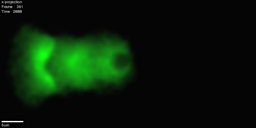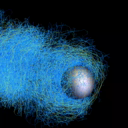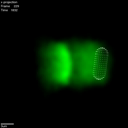Difference between revisions of "CometWiki"
m |
m |
||
| Line 16: | Line 16: | ||
In actin-based bead motility, we coat a bead with proteins that normally tell the cell to polymerize actin, then put the bead a solution similar to that inside of the cell, which causes an actin network to build around the bead. Surprisingly, even when the bead is spherically symmetric, rather than just building a symmetric shell that gets bigger and bigger, it moves off in 'comet tail' of actin. This bead motility simulator aims to help us understand how this process works. | In actin-based bead motility, we coat a bead with proteins that normally tell the cell to polymerize actin, then put the bead a solution similar to that inside of the cell, which causes an actin network to build around the bead. Surprisingly, even when the bead is spherically symmetric, rather than just building a symmetric shell that gets bigger and bigger, it moves off in 'comet tail' of actin. This bead motility simulator aims to help us understand how this process works. | ||
| − | == | + | |width="200" valign="top"| |
| − | == | + | ==Code Status== |
| − | *[ | + | *[http://www.dayel.com/git/comet.git Source Repository] |
| − | *[ | + | *[http://www.dayel.com/git/comet.git?a=tree;h=refs/heads/master;hb=master Source Files] |
| − | *[ | + | *[http://www.dayel.com/comet/bin Download Binaries] |
| − | + | ||
| − | + | *[[Known Issues]] | |
| − | *[[ | + | *[[To Do]] |
| − | + | *[[Using Git]] | |
| − | *[[ | + | |
| − | + | ||
| + | ==Supplementary Materials== | ||
| + | *[http://www.dayel.com/comet/SupplementaryMaterials/ Supplementary Materials] | ||
| + | |||
| + | |valign="top"| | ||
| + | |} | ||
| + | |||
| + | {|cellpadding="10" | ||
| + | |width=300px valign="top"| | ||
==Essential Information== | ==Essential Information== | ||
| + | |||
| + | ===How the program works=== | ||
| + | |||
| + | *[[Description of the Model]] | ||
| + | *[[Program Flow|Overview of Program Flow]] | ||
| + | *[[Detailed Program Flow]] | ||
| + | *[[Implementation in C++]] | ||
===Installing the program=== | ===Installing the program=== | ||
| Line 49: | Line 61: | ||
*[[Display settings|Display settings in the <code>cometparams.ini</code> file]] | *[[Display settings|Display settings in the <code>cometparams.ini</code> file]] | ||
*[[Running comet on a cluster|Running <code>comet</code> on a cluster]] | *[[Running comet on a cluster|Running <code>comet</code> on a cluster]] | ||
| − | |||
| − | |||
| − | |||
| − | |||
| − | |||
| − | |||
| − | |||
| − | |||
==In Depth Information== | ==In Depth Information== | ||
| Line 64: | Line 68: | ||
*[[Radial Force Movies]] | *[[Radial Force Movies]] | ||
| − | | | + | | valign="top"| |
| + | ==Simulator Output== | ||
| + | ===Example Results=== | ||
| − | + | *[[Symmetry Breaking and Motility]] | |
| + | *[[Forces during Symmetry Breaking]] | ||
| + | *[[Circumferential and Radial measurements]] | ||
| + | *[[Ellipsoid and Capsule symmetry breaking]] | ||
| − | + | ===Model Robustness=== | |
| − | + | *[[Model Robustness|The effect of changing the main parameters]] | |
| − | *[ | + | |
| − | + | ===In Vitro=== | |
| − | *[[ | + | *[[3D Reconstructions of in vitro Constrained Shells]] |
| − | + | *[[3D Reconstructions of in vitro Unconstrained Shells]] | |
| − | *[[ | + | |
| − | + | ||
| − | + | ||
| − | + | ||
| − | + | ||
|valign="top"| | |valign="top"| | ||
|} | |} | ||
Revision as of 08:50, 16 June 2009
CometWiki
IntroductionThis site describes the set up and usage of `comet', an actin-based bead motility simulator. Cells in our body use actin to move. Unlike the actin-myosin interaction that produces muscle movement, this kind of movement is on a much smaller scale---the scale of individual cells---and allows, for example, neurons to migrate and wire up to the right part of the brain, and cells in our immune system to track down and engulf bacteria. To achieve this movement, cells lay down actin polymer networks that produce force. One way to study how our cells use actin to produce force and move is to study a simplified system which still recreates actin-based motility in vitro, such as 'actin-based bead motility'. In actin-based bead motility, we coat a bead with proteins that normally tell the cell to polymerize actin, then put the bead a solution similar to that inside of the cell, which causes an actin network to build around the bead. Surprisingly, even when the bead is spherically symmetric, rather than just building a symmetric shell that gets bigger and bigger, it moves off in 'comet tail' of actin. This bead motility simulator aims to help us understand how this process works. |
Code StatusSupplementary Materials |
Essential InformationHow the program worksInstalling the program
Running the programThe program is called from the command line. The command line parameters tell the program what to do (calculate a new run, re-process existing data, interactive 3D view etc.). A
In Depth InformationMaking Measurments |
Simulator OutputExample Results
Model RobustnessIn Vitro |


